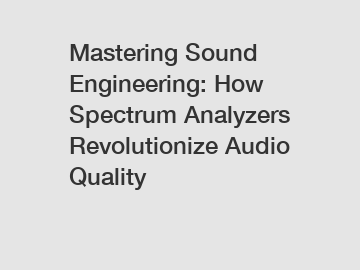Mastering Sound Engineering: How Spectrum Analyzers Revolutionize Audio Quality
Google Hot Topics: Mastering Sound Engineering.
Mastering sound engineering is a complex endeavor that requires a deep understanding of audio quality and how to achieve the best possible outcome. One technology that has revolutionized this field is spectrum analyzers. In this article, we explore the role of spectrum analyzers in enhancing audio quality and discuss their significance in sound engineering.
I. Understanding Spectrum Analyzers:

Spectrum analyzers are essential tools for sound engineers as they provide a visual representation of the frequency spectrum of an audio signal. By measuring and displaying the frequency content of the sound, these analyzers help engineers identify and address any issues within the audio signal.
A. Frequency Analysis:
Spectrum analyzers break down an audio signal into its individual frequency components, allowing engineers to analyze different aspects of the sound. By examining peaks and dips in the spectrum, sound engineers can identify unwanted noise, room resonances, and tonal imbalances that may affect the overall audio quality.
B. Real-time Monitoring:
One of the significant advantages of spectrum analyzers is their ability to provide real-time monitoring of the audio signal. Engineers can observe the frequency spectrum while sound is being played, enabling them to make immediate adjustments and fine-tune the audio to achieve optimal quality.
II. Optimizing Audio Quality Using Spectrum Analyzers:
A. EQ Adjustments:
Spectrum analyzers allow engineers to make precise equalizer (EQ) adjustments for better audio quality. By identifying frequency imbalances or unevenness, sound engineers can equalize the sound accordingly, ensuring a pleasant listening experience. Using the data provided by the spectrum analyzer, engineers can precisely target problem frequencies and adjust the EQ settings to enhance clarity and balance.
B. Filtering Unwanted Noise:
Background noise or unwanted frequencies can significantly impact audio quality. Spectrum analyzers help sound engineers identify and filter out these unwanted components, allowing the audio to shine. By fine-tuning the sound using filters or implementing noise reduction techniques, engineers can minimize distractions and enhance the overall audio experience.
III. Mastering Audio with Spectrum Analyzers:
A. Balancing Instruments:
Sound engineers often face the challenge of balancing multiple instruments within a mix. Using a spectrum analyzer, they can visualize the frequency content of each instrument and ensure that they occupy their respective frequency ranges without clashing with one another. This enables engineers to achieve a well-balanced and cohesive mix that preserves each instrument's character.
B. Room Acoustics:
Room acoustics play a critical role in sound engineering. Spectrum analyzers can help sound engineers identify and address acoustic issues such as room resonances, echoes, or unwanted reflections. By understanding the characteristics of the room through frequency analysis, engineers can make informed decisions on microphone placement, speaker positioning, and acoustic treatment, ultimately improving the quality of the audio produced in that space.
Conclusion:
Spectrum analyzers have revolutionized sound engineering by providing valuable visual insights into the frequency content of audio signals. With their ability to analyze, monitor, and fine-tune sound in real-time, they empower sound engineers to optimize audio quality, make precise EQ adjustments, filter out unwanted noise, and balance instruments effectively. By leveraging the power of spectrum analyzers, sound engineers can achieve exceptional audio quality that captivates listeners and enhances the overall audio experience. Mastering sound engineering is an ever-evolving process, and spectrum analyzers remain indispensable tools for ensuring remarkable audio quality.
If you want to learn more, please visit our website What Are Signal Generators Used For, Spectrum Analyzer Uses, Reciprocal Counter.

Comments
0